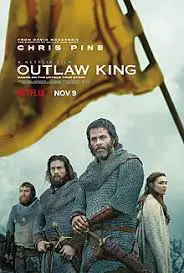How Historically Accurate is the Outlaw King
Many of us know the story of Braveheart, where William Wallace leads a major rebellion against Edward I in the late 13th century. That movie did not only show the English as repressing the Scots but it also showed another prominent Scottish figure, Robert the Bruce, as being supplicant to the English and enabling their actions until finally he successfully revolts against the English during the reign of Edward II. Many historians had criticized this aspect, where Robert the Bruce was shown in a negative light. In fact, Robert the Bruce, along with many Scots, did for a time accept Edward I as the king, but Robert the Bruce may have actually simply weighted and calculated for an opportune time rather than risk a rebellion that was likely to fail. The Netflix movie Outlaw King tells his story and the making of Scotland that was free of English rule.
The Main Story
The story begins with Robert the Bruce, along with other prominent Scottish nobles, meeting with Edward I to accept him as their king in around 1306. They had already led a rebellion that was unsuccessful, where Edward I, Hammer of the Scots, had earned his nickname by winning against the Scots. Robert still wants to be king, as his family has ancient lineage to the thrown of Scotland, but other claimants exist for the Scottish throne and none of them are in position to attack the English due to their strength and possession of many key areas of Scotland. John Comyn was another Scottish noble who also had perhaps just an equal or maybe stronger claim to the Scottish throne.
William Wallace is the last major Scottish figure not to accept Edward I as king. Eventually, after several years of being on the run and hiding in the highlands and other regions, William is killed. This is shown in the movie as inspiring rebellion against the English, that the death of Wallace somehow triggers a nationalist rage that sparks Robert to begin to plot to take back Scotland. As the Bruce begins to plot the rebellion, he meets with Comyn in Greyfriars church. However, the two quickly make their own claims to the throne of Scotland and Comyn does not show willingness to side with the Bruce against Edward I. This leads to Robert the Bruce striking and later Comyn dies, which leads to the Bruce being excommunicated but being absolved by the Scottish church leaders as they promoted the rebellion. Six weeks later, Bishop William de Lamberton crowned the Bruce King of the Scots at Scone, which was the traditional place that Scottish kings were crowned. However, despite this, many Scottish nobles did not join his rebellion and he was betrayed, which almost led to his capture but he escaped with a few followers. In fact, at the Battle of Methven where the Bruce and his army was almost destroyed, Aymer de Valence defeated him in a surprise attack. After this, the Bruce may have spent the winter of 1306-1307 in the Hebrides. His wife, Elizabeth de Burgh, was hiding in Kildrummy Castle after this battle, but she was captured after a siege of the castle that was guarded by Robert the Bruce's brother (Niall Bruce). After the castle fell, Niall Bruce was executed.
From that time on, Robert the Bruce had realized to defeat the English he would have to conduct a most Guerilla war. This proved to be very successful and he began to have some success in attacking the English in places they did not expect. When he did next meet the English in battle, he wanted to choose the ground where the battle would be. In May 1307, the advantage point for him was at Loundoun hill, a place that was trapped on either side by marshes. While the Bruce was aware of this, the English were not. They saw his small army that was poorly equipped and fell into his trap. They had also produced trenches that restricted English movements to areas that were prepared with spears. Robert the Bruce was attacked by Aymer de Valence, once again, but this time he had made conditions perfect for his victory, which he was able to take.
While the movie ends there, it is clear that this was a turning point. Soon after this battle, Edward II took over England from his father after he had died and he was far less able. After more successful operations and defeat of the English at the Battle of Bannockburn, where once again Robert the Bruce had to use creative tactics to makeup for his inferior numbers. After that time, it was Robert the Bruce who launched invasions on the English and was later recognized as the Scottish king by Edward II's successor, Edward III.
